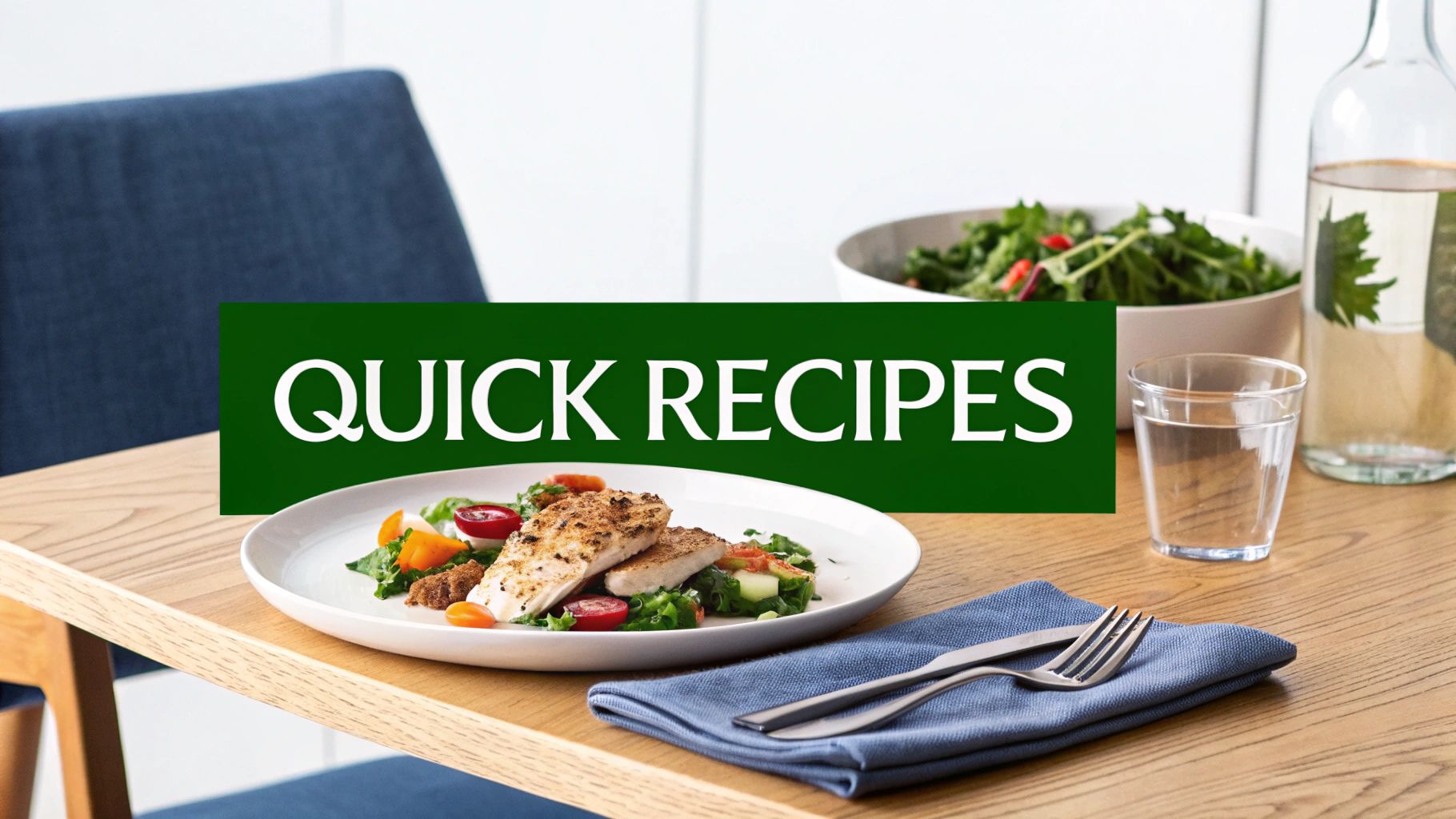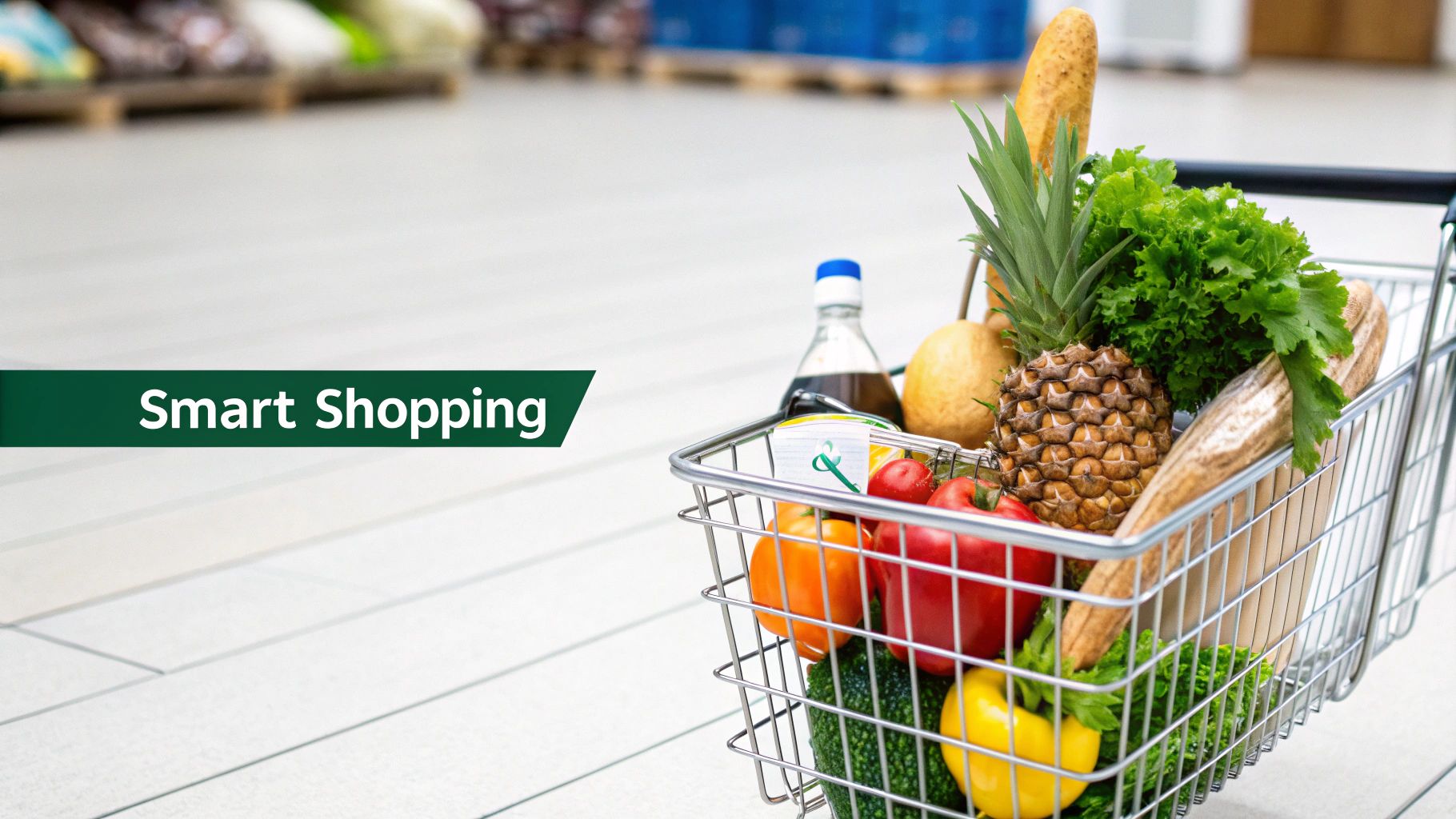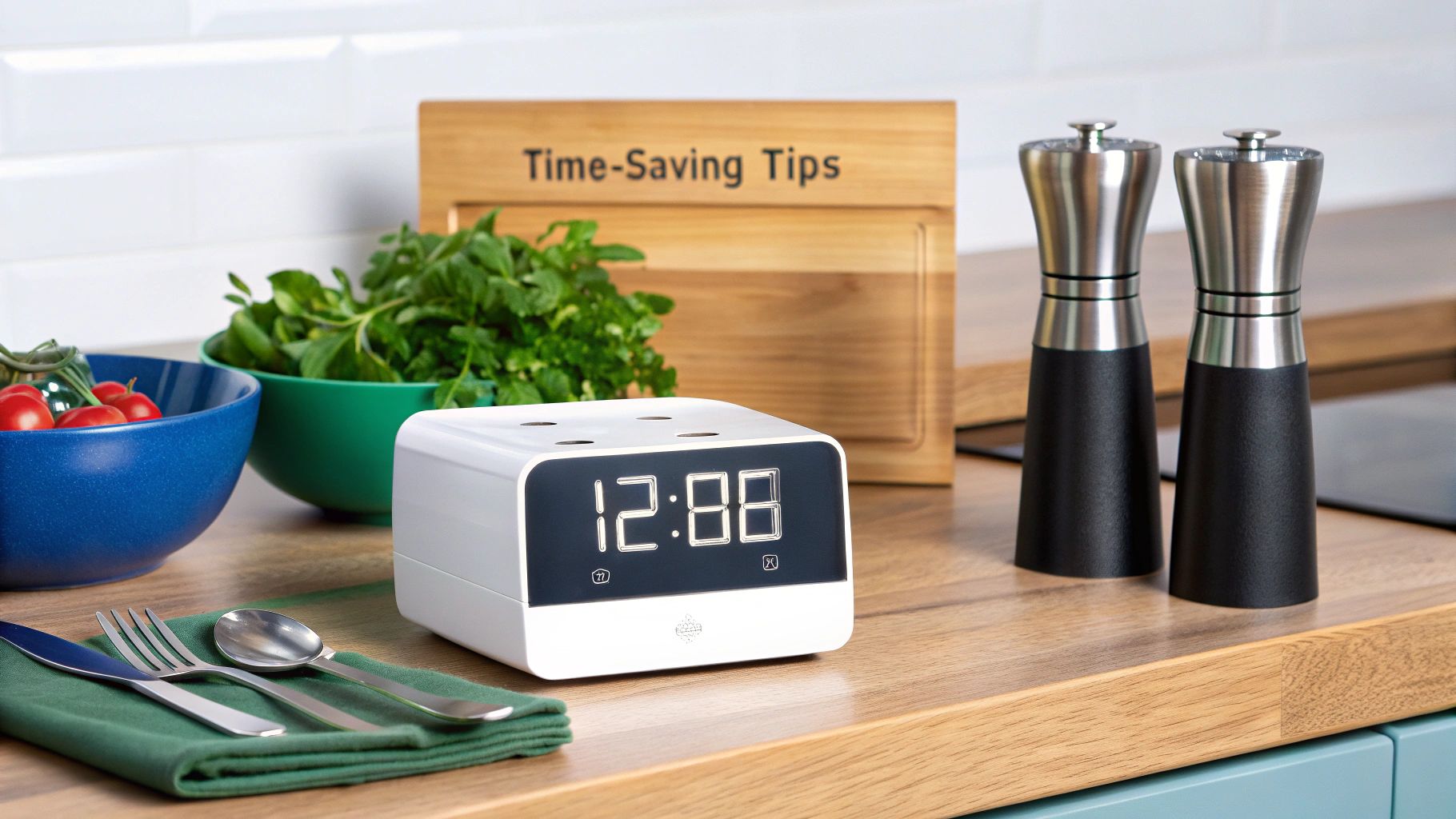Meal Planning for Busy Schedules: Top Quick Tips
Discover meal planning for busy schedules tips to simplify weeknight meals. Save time and eat healthy with quick, proven techniques for efficient cooking.
Ready to Simplify Your Meal Planning?
Get personalized meal plans and grocery lists automatically matched to your macro targets.

Meal Planning for Busy Schedules: Top Quick Tips
Why Smart Meal Planning Actually Matters When You're Busy

Let's be honest, when life gets hectic, cooking often takes a backseat. Takeout and unhealthy convenience foods become the go-to, leaving us feeling guilty and frustrated. But what if there's a better way? Meal planning offers a powerful solution to this all-too-common problem. It’s about taking charge of your time, health, and well-being. Let's dive into the real benefits of meal planning for busy schedules.
Reducing the Mental Load
One of the biggest, yet often overlooked, perks of meal planning is how it reduces your mental load. Constantly wondering "What's for dinner?" consumes mental energy that you could be using for other things. Think of it like this: you have a designated "brain space" for meal decisions. Meal planning frees up that space, leaving you to focus on other important tasks. The result? Less stress and a clearer mind throughout the week.
Time Savings and Efficiency
Meal planning also streamlines your grocery shopping and cooking. With a structured plan, you can say goodbye to aimlessly wandering the supermarket aisles and hello to targeted shopping. This saves you precious time and money. Plus, having prepped ingredients on hand eliminates that dreaded "starting from scratch" feeling on hectic weeknights. Cooking becomes faster and, dare we say, even enjoyable!
Health and Dietary Improvements
Meal planning isn't just about saving time; it’s a game-changer for your health too. Studies show that over 57% of people report planning their meals at least sometimes. It’s linked to better adherence to nutritional guidelines and greater food variety. This can lead to a lower chance of being overweight or obese. People who plan their meals tend to have healthier eating habits overall. Want to explore this more? Check out this fascinating study here. So, even when time is tight, you can nourish your body with healthy meals, all thanks to a little planning.
Minimizing Food Waste
Finally, a well-designed meal plan significantly reduces food waste. By buying only what you need and strategically using leftovers, you'll throw away less food. This not only saves you money but also contributes to a more sustainable lifestyle. For anyone looking to simplify their life and prioritize their well-being, especially those with busy schedules, meal planning is a must.
Real-World Meal Planning for Different Life Scenarios

Let's face it, juggling life's demands often leaves us scrambling when it comes to food. What works for a high-flying executive might not cut it for a parent wrangling toddlers. This section dives into meal planning strategies designed for various lifestyles, pulling wisdom from real-world kitchens.
The Executive's Desk Lunch Dilemma
Busy executives often find themselves trapped in a whirlwind of meetings and deadlines, leaving healthy eating in the dust. Grabbing fast food or skipping lunch altogether becomes the default, ultimately impacting energy levels and productivity. But don't despair! Desk lunches can be both nutritious and enjoyable with a bit of planning. Batch-preparing protein-rich salads or grain bowls on the weekend sets you up for a healthy and satisfying midday meal throughout the week. The trick is to choose versatile ingredients that stay fresh and mix-and-match easily.
Navigating Family Mealtime Mayhem
Parents with young children face a unique set of culinary challenges: picky eaters, limited time, and the constant quest for kid-friendly options. Meal planning here requires a healthy dose of creativity and adaptability. Transforming weekend cooking into versatile components is a lifesaver. Think roasted chicken: shredded for tacos one night, tossed into pasta the next. Getting children involved in age-appropriate meal prep tasks can also lighten the load and cultivate healthy eating habits.
The Frequent Traveler's Food Predicament
Maintaining a healthy diet on the road can feel like mission impossible. Erratic schedules and limited kitchen access can sabotage even the most meticulous meal plans. But frequent travelers can still prioritize their nutrition. Packing non-perishable snacks like nuts, seeds, and protein bars provides a reliable backup when healthy options are scarce, ensuring nutritional needs are met even during airport delays or when faced with limited restaurant choices. Researching healthy restaurants near hotels or meeting locations in advance helps avoid the siren call of unhealthy convenience foods.
Young Adults and Time Constraints
Juggling work, school, and a social life can make meal planning a major hurdle for young adults. Many face serious time constraints in maintaining a healthy diet. Research shows that women and students with lower socioeconomic status often perceive greater time constraints for meal preparation. Learn more about the challenges young adults face regarding healthy eating here. This highlights the need for personalized meal planning strategies to tackle these specific challenges. Mastering a few simple, quick recipes and using time-saving techniques like batch cooking can empower young adults to prioritize healthy eating even with busy schedules. One-pan meals or slow cooker recipes maximize efficiency and minimize cleanup, making healthy eating more achievable.
Let's dive into some specific approaches that can help you conquer meal planning, no matter your lifestyle:
To help illustrate these different strategies, let's take a look at the table below:
Meal Planning Approaches by Lifestyle: This table compares different meal planning strategies based on various lifestyle needs and time constraints.
| Lifestyle Type | Time Constraints | Recommended Planning Method | Key Benefits |
| Busy Executive | High | Weekend batch cooking of versatile components (salads, grain bowls) | Saves time during the week, ensures healthy desk lunches |
| Parent with Young Children | Moderate | Weekend cooking of adaptable components (roasted chicken, roasted vegetables), involving children in meal prep | Reduces weeknight stress, minimizes picky eater battles, encourages family participation |
| Frequent Traveler | High | Packing non-perishable snacks, researching healthy restaurants in advance | Maintains nutrition on the go, avoids unhealthy convenience foods |
| Young Adult | Moderate to High | Mastering quick recipes, batch cooking, one-pan/slow cooker meals | Simplifies healthy eating, fits busy schedules, minimizes cooking time and cleanup |
As you can see, adapting your meal planning strategy to your specific circumstances can make a world of difference in your ability to eat healthy and enjoy mealtimes, no matter how busy life gets. Choose the approach that best suits your needs and get ready to conquer your kitchen!
The 60-Minute Weekend Method: Setting Up Your Entire Week

Wish you could wave a magic wand and have your meals planned and prepped for the entire week? While we can't offer actual magic, this 60-Minute Weekend Method comes pretty close. It's the perfect way to turn a Sunday afternoon into a meal-prep powerhouse, ensuring delicious, adaptable meals without sacrificing your precious weekend.
Step 1: Strategic Grocery Shopping (15 Minutes)
Forget aimless wandering through the grocery aisles. Start with a laser-focused shopping list organized by store layout. This is your treasure map to shopping efficiency! Prioritize versatile ingredients like roasted chicken, quinoa, and roasted veggies. These culinary chameleons can be transformed throughout the week, preventing meal boredom and saving you precious cooking time.
Step 2: Kitchen Setup and Batch Cooking (25 Minutes)
Back home, it's time to channel your inner chef. Organize your kitchen like a pro – think "mise en place." Wash and chop those veggies, portion out ingredients, and prepare any base components like cooked grains or roasted proteins. Batch cooking is your secret weapon here. Roast a whole chicken on Sunday, shred it for tacos on Monday, and add it to salads on Tuesday. Boom! Time saved.
Step 3: Proper Cooling and Storage (15 Minutes)
Now that you’ve cooked up a storm, let's talk food safety. Proper cooling and storage are vital for keeping your meals fresh and delicious. Allow cooked food to cool completely before storing it in airtight containers. This prevents unwanted bacterial growth and ensures your meals stay tasty throughout the week. It's a small time investment that pays big dividends in flavor and peace of mind.
Step 4: Creative Repurposing Throughout the Week (5 Minutes)
Here's where the fun begins! Remember those versatile veggies? They can be a simple side dish one night, a tasty addition to an omelet the next morning, and a star player in a grain bowl later in the week. This strategy minimizes cooking time without sacrificing variety. Americans spend, on average, 37 minutes daily on meal prep and cleanup. While fast food might seem like a 30-minute time-saver (or even more for working families), it's often a less healthy choice. Check out these stats: http://www.ers.usda.gov/amber-waves/2016/november/americans-spend-an-average-of-37-minutes-a-day-preparing-and-serving-food-and-cleaning-up. The 60-Minute Weekend Method offers a healthier, long-term solution. By investing just one hour on the weekend, you reclaim your weeknights and enjoy delicious, home-cooked meals without the daily scramble. It’s time to ditch the convenience foods and embrace a week of stress-free, healthy eating.
Shopping Strategies That Save Time, Money, and Sanity

The grocery store: a battlefield of meal plans. Will yours emerge victorious? The secret weapon? Efficient shopping. Let's turn those chaotic grocery runs into strategic shopping missions.
Mastering the Art of the Store-Specific List
Forget generic shopping lists. Imagine one tailored to your meals and your store's layout. This is your secret weapon for saving precious time. Organize your list by store department. Produce first, then dairy, grains, and so on. No more backtracking! You'll be zipping through aisles like a pro, grabbing everything you need in one smooth sweep.
Pre-Prepped Ingredients: Time-Savers or Budget Busters?
Pre-cut veggies and pre-cooked grains whisper promises of saved time. But they often come with a premium price tag. The trick? Knowing which pre-prepped items are actually worth it. Pre-washed salad? Yes! Pre-chopped onions? Maybe not. A little discernment goes a long way in protecting both your time and your wallet.
Harnessing the Power of Digital Tools
Your smartphone: it's not just for scrolling. Grocery store apps with digital coupons and personalized recommendations can be game-changers. They can even track your spending and uncover hidden savings. Talk about taking control of your grocery budget! And don't forget the power of a meal planning app like Meal Flow AI. Generate personalized meal plans and automatically create shopping lists, ready for seamless grocery delivery. Who needs manual list-making anyway?
Building a Smart and Versatile Pantry
A well-stocked pantry is a meal planner's best friend. Keep it filled with versatile staples like canned beans, lentils, whole grains, and spices. These are your building blocks for quick, nutritious meals, even when you're short on time. Unexpected schedule change? No problem! Your pantry is ready to handle any last-minute meal pivots.
Inventory Management Without the Spreadsheet Nightmare
Knowing what's in your fridge and pantry can prevent food waste and ensure you're always ready to cook. Forget complicated spreadsheets! Simple tricks, like designating a shelf for soon-to-expire items, can make all the difference. You'll use those ingredients before they go bad, minimizing waste and maximizing your budget. Smart, right?
Digital Tools That Transform Meal Planning Efficiency
Forget frantic last-minute dashes to the grocery store and the eternal "what's for dinner?" dilemma. Beyond your grandma's trusty recipe box, a whole universe of digital tools exists to rescue your meal planning routine. These clever apps and gadgets can be your secret weapon in the quest for a stress-free kitchen. Let's dive into how they can bring a little more zen to your dining table.
Meal Planning Apps: Your Digital Sous Chef
Tired of endlessly scrolling through recipe websites? Meal planning apps are here to save the day. These digital sous chefs provide a one-stop shop for recipe discovery, meal scheduling, and even grocery list creation. They're designed with busy lifestyles in mind and often cater to a wide range of dietary needs and preferences, making them perfect for families and individuals alike.
- Personalized Meal Plans: Say goodbye to decision fatigue. Many apps whip up personalized meal plans based on your dietary restrictions, favorite cuisines, and even the ingredients you already have on hand. It's like having a personal chef (minus the hefty price tag).
- Automated Shopping Lists: No more scribbled notes on the back of napkins. These apps automatically generate shopping lists based on your chosen meal plan, transforming grocery shopping from a chore into a breeze. Some even integrate with grocery delivery services for the ultimate in convenience.
- Nutritional Tracking: Keeping an eye on your health goals? Select apps offer detailed nutritional breakdowns for each meal, making it easier than ever to stay on track with your dietary needs.
For example, Meal Flow AI is an AI-powered meal planning platform that not only creates personalized meal plans but also generates automated Instacart shopping lists for seamless grocery delivery. Check out the magic of Meal Flow AI here.
Before we explore more helpful tools, let's take a look at a comparison of some popular meal planning apps:
Meal Planning App Comparison
This table compares the features, pricing, and benefits of popular meal planning applications for busy people.
| App Name | Key Features | Price | Best For | Time-Saving Rating |
| Mealime | Personalized meal plans, dietary restrictions, grocery lists | Free, Premium option | Busy individuals and couples | 4/5 |
| Paprika | Recipe organization, meal planning, pantry tracking | One-time purchase | Serious home cooks | 4.5/5 |
| PlateJoy | Personalized meal plans, dietary restrictions, nutritional tracking | Subscription | Health-conscious individuals | 3.5/5 |
| Meal Flow AI | AI-powered meal plans, Instacart integration | Free, premium features | Streamlined grocery delivery | 5/5 |
As you can see, various options cater to different needs and budgets. Choosing the right app can significantly boost your meal planning efficiency.
Smart Kitchen Devices: Automating Your Cooking Routine
Ready to take your meal planning game to the next level? Smart kitchen devices can be a fantastic addition to your culinary arsenal.
- Smart Refrigerators: Imagine a fridge that keeps track of expiration dates and suggests recipes based on what's inside. Some smart refrigerators do just that, minimizing food waste and providing endless meal inspiration.
- Connected Scales and Measuring Tools: Precise measurements are key to culinary success. Connected scales and measuring tools ensure accurate portioning and ingredient measurements, crucial for following recipes and staying consistent with your dietary goals.
- Voice-Activated Assistants: Need a timer? Want to convert cups to ounces? Voice-activated assistants like Alexa can provide hands-free help in the kitchen, freeing you up to focus on the art of cooking.
While these devices aren't essential, they can add a touch of futuristic flair and further streamline your meal planning process.
Grocery Delivery Services: Reclaiming Your Weekend
Grocery delivery services are a game-changer for busy individuals. By outsourcing the shopping trip, you reclaim precious weekend hours for activities you actually enjoy. Many services offer convenient scheduling options and even allow you to save favorite items for quick reordering, making grocery shopping practically effortless. Just remember to compare prices and delivery fees across different services to find the best fit for your budget.
Digital Templates and Calendar Integrations: Staying Organized
Staying organized is crucial for successful meal planning. Downloadable meal planning templates provide a structured framework for mapping out your weekly meals. Integrating your meal plan with your digital calendar sets helpful reminders and ensures mealtimes stay top of mind. This simple step can significantly reduce the mental load of remembering what’s on the menu each night.
By combining these digital tools, you create a powerful system for conquering meal planning, even with the busiest of schedules. From personalized meal plans to automated grocery lists and smart kitchen gadgets, these resources offer flexibility and control, empowering you to reclaim your time and enjoy the delicious rewards of a well-planned meal.
Maintaining Nutrition When You Barely Have Time to Eat
Life's a whirlwind, right? Between juggling work, family, and everything in between, healthy eating often takes a backseat. But guess what? Maintaining good nutrition, even when you're constantly on the go, is totally doable. It just takes a little planning and some clever strategies. Let's dive into how you can fuel your body effectively, even with a jam-packed schedule.
The Formula for Quick, Nutrient-Dense Meals
Whipping up a nutritious meal doesn't require spending hours in the kitchen. It's all about combining nutrient-rich ingredients strategically for maximum flavor and efficiency. Think of it as building with nutritional blocks:
- Protein Powerhouse: Begin with lean protein like grilled chicken, fish, beans, lentils, or tofu. Protein keeps you feeling full and satisfied, preventing those pesky energy crashes and unhealthy cravings.
- Fiber Up: Next, load up on fiber-rich vegetables. These nutritional all-stars are bursting with vitamins, minerals, and antioxidants. Frozen or pre-cut veggies are your time-saving secret weapons.
- Healthy Fats: Don't forget the healthy fats! Avocado, nuts, seeds, or olive oil provide essential nutrients and help your body absorb vitamins.
- Complex Carbohydrates (Optional): If you’re adding carbs, opt for the complex kind like brown rice, quinoa, or sweet potatoes. They deliver sustained energy and won't send your blood sugar soaring.
For a quick and easy meal, try a grilled chicken salad with mixed greens, chopped bell peppers, avocado, and a light vinaigrette. This meal delivers a balanced combo of protein, fiber, and healthy fats.
Deciphering Convenience Foods: Separating Fact from Fiction
Convenience foods often promise speed, but not all are created equal. Learning to navigate the world of convenience foods is crucial for making healthy choices on the fly.
- Read Labels Carefully: Don't let flashy packaging fool you. Scrutinize nutrition labels for sneaky sugars, excessive sodium, and unhealthy fats. Look for options high in protein and fiber and minimally processed.
- Prioritize Whole Foods: Even when time is tight, choose convenience foods closest to their whole-food form. Think pre-washed salad mixes, frozen fruits and vegetables, or pre-cooked grains.
- Beware of "Health Halos": Some foods pretend to be healthy but are loaded with hidden sugars or unhealthy fats. Granola bars, flavored yogurts, and some protein shakes can be surprisingly high in sugar or unhealthy additives.
Smart Shortcuts That Preserve Nutritional Value
Meal prepping doesn't have to be an all-or-nothing affair. Small, strategic shortcuts can make a huge difference in your ability to eat healthy during a busy week.
- Batch Cooking Basics: Cook extra grains, beans, or roasted vegetables on the weekend and store them for easy meal assembly throughout the week.
- Embrace One-Pan or Slow Cooker Meals: These cooking methods minimize cooking time and cleanup, making healthy eating more achievable on hectic weeknights. Check out some slow cooker recipes if you're looking for inspiration!
- Strategic Leftovers: Plan for leftovers! Double your dinner recipe and enjoy the second half for lunch the next day. This simple trick eliminates the need to cook a separate lunch.
Simple Meal Templates for Balanced Nutrition
Creating meal templates is like having a cheat code for healthy eating. Develop a few go-to meal formulas you can easily adapt based on what you have on hand. For example:
- Protein + Vegetable + Healthy Fat: Grilled salmon with roasted asparagus and a drizzle of olive oil.
- Protein + Salad + Whole Grain: Chicken breast over a mixed green salad with quinoa.
- Soup + Whole Grain Bread: Lentil soup with a slice of whole-wheat bread.
These templates ensure balanced nutrition without requiring extensive planning. By incorporating these strategies, you can maintain good nutrition even when time is scarce. Remember, healthy eating doesn't require perfection. Small, consistent efforts can have a big impact on your overall health and well-being.
Ready to simplify healthy eating? Meal Flow AI is an AI-powered meal planning platform that creates personalized meal plans and automatically generates Instacart shopping lists. Check out Meal Flow AI at https://mealflow.ai and transform your meal planning experience.